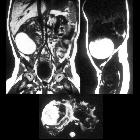tubal torsion
A Fallopian tube torsion is a type of adnexal torsion and usually occurs in association with an ovarian torsion (when it is then termed a tubo-ovarian torsion). An isolated fallopian tube torsion is rare but can occur.
Pathology
An isolated tubal torsion can occur as a late complication of tubal ligation .
Other risk factors for an isolated fallopian tube torsion include
- intrinsic factors
- pelvic inflammatory disease (PID)
- anatomical abnormalities
- hydrosalpinx
- hematosalpinx: can also be a consequence
- long mesosalpinx
- physiological abnormalities
- tubal spasm
- hypermotility of tube
- tubal neoplasm
- extrinsic factors
- adhesions
- adnexal venous congestion
- adjacent ovarian or paraovarian masses (e.g. paraovarian cysts)
- uterine masses
- gravid uterus
Location
There is a well-recognized right-sided predilection
Radiographic features
Ultrasound
Reported sonographic findings include
- a normal-appearing uterus and ovaries with normal flow
- free fluid
- a dilated tube with thickened, echogenic walls and internal debris
- a convoluted echogenic mass thought to represent a thickened, torsed tube
- sonographic whirlpool sign: described as a relatively specific sign of tubal torsion
CT
Reported primary CT findings of isolated tubal torsion include
- an adnexal mass
- twisted appearance to the fallopian tube with dilated tube greater than 15 mm
- thickened and enhancing tubal wall and luminal CT attenuation greater than 50 HU, compatible with hemorrhage
Secondary signs include
- free intrapelvic fluid
- peritubular fat stranding
- enhancement and thickening of the broad ligament
- regional ileus
Siehe auch:
- Ovarialtorsion
- Intrauterinpessar
- tubal ectopic pregnancy
- Hydrosalpinx
- Unterleibsentzündung
- Morgagni-Hydatide
- haematosalpinx
- Tubenruptur
- tubal spasm
und weiter:
 Assoziationen und Differentialdiagnosen zu Tubentorsion:
Assoziationen und Differentialdiagnosen zu Tubentorsion:







